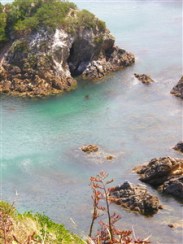The Resource Management Amendment Act (RMAA 2009) seemed like a good idea at the time – and so did the Green Growth Advisory Group.
The National government’s 2009 amendment to the Resource Management Act 1991 is intended to streamline and simplify. There are a raft of projects affected by this legislation. These projects dismiss some of the usual checks and balances regarding environmental and other ‘costs’ in favour of ‘streamlining.’
So, why’s that a problem?
In many cases it probably isn’t. If projects get off the ground quickly, we save on litigation and other time-consuming processes, and that means delivering growth at less cost – and isn’t that the point?
Well, perhaps not entirely. Sir Paul Callaghan recently delivered a challenge to New Zealanders – to make New Zealand a place where talent wants to live. He was referring to the small bunch of talented people who are part of an equally small number of top earning businesses quietly achieving impressive productivity outcomes across the country.
These are businesses delivering huge returns, even when compared to our two notable earner industries, dairy and tourism – and with barely a negative imprint on the environment. They include companies like Fisher and Pykel Healthcare and Weta Digital.
Our wellbeing and our prosperity, our ability to pay our debts, are dependent on growing our productivity – and that doesn’t necessarily mean working harder – or longer, or doing away with lower-productivity businesses that support the things we do and care about – like rest-home carers, cafe workers, and researchers – like me.
Cliche it may be – but building prosperity is about working smarter and developing more businesses based around people and innovation – businesses that deliver higher earnings per worker. Callaghan’s recent example is that a McDonald’s worker produces $75.00 of value to the company, while a Samsung employee creates $1.0 million. In New Zealand, the likes of Fonterra produce a good return, around $130.00 per worker, while tourism earnings sit at around $90. Mining low-energy coal is likely to produce even less per worker, and at what cost to the environment?
The Green Growth Advisory group was launched with some fanfare in January this year. It is tasked with promoting the ‘greening-up’ of small and medium sized businesses, growing clean technology and innovation, and moving towards a low-carbon economy. But big business has been left out of its terms of reference – an omission the taxpayer will pay for in spades, according to Parliamentary Commissioner for the Environment, Jan Wright.
My question is this: Why are we so actively pursuing environmentally-costly programmes to mine our resources (oil-drilling might be one example, but I am uneducated about the impacts, so would just ask; have the environmental consequences been truly considered?). We have just launched the first of three stages of lignite mining in Southland (see my previous post). My particular gripe – why spend 100 million on feasibility studies when the Parliamentary Commissioner has already condemned this project? Economics seems to rule supreme – and that should worry us.

Australian PM Julia Gillard – ‘Getting the carbon tax ball rolling’ – cartoon by http://www.inkcinct.com.au
The Green Growth Advisory Group’s report, due in December, is destined to disappoint many who supported its intent – the main criticism being the exemption of the big emitters from accounting for the overall costs of doing business – and so leaving out the costs of polluting when making crucial investment decisions – like those of SOE Solid Energy.
We need to make better decisions that really do look out for the long term wellbeing and prosperity of all New Zealanders. That means that as we do business, we also must act on restoring and enhancing the intrinsic water, air and landscape qualities that make New Zealand the place we love to live – Then we’ll have the New Zealand we deserve. The place where talent wants to live.
(See the recent Sir Paul Callaghan address http://www.r2.co.nz/20110519/).
Professor Callaghan was made a Fellow of the Royal Society of London in 2001. He was awarded the Ampere Prize in 2004 and the Rutherford Medal in 2005. In 2006, he was appointed a Principal Companion of the New Zealand Order of Merit and in 2007 he was recognised by a KEA/NZTE World Class New Zealander Award and received the Sir Peter Blake Medal. Knighted in 2009, the following year he was awarded the Gunther Laukien Prize for Magnetic Resonance, and shared the New Zealand Prime Minister’s Science Prize in 2010. In 2011, he was named Kiwibank New Zealander of the Year and was made Honorary Fellow of Corpus Christi College, Cambridge. Thanks to the Royal Society of New Zealand and Victorius (Autumn 2012) for this bio.
Update March 2012: Remembering Sir Paul
Mourning the passing of world-leading physicist, innovator, humanitarian, uber-educator, Professor Sir Paul Callaghan (1947-2012). Ardent advocate for a more resilient and prosperous New Zealand, Sir Paul’s contributions are immeasurable.
Professor Sir Paul Terence Callaghan, scientist; b Whanganui, 19 August 1947; m Susan Audrey Roberts (dis), m Miang Lim; 1s 1d; d Wellington, March 24, aged 64.
Related articles
- Mining lignite in Aotearoa NZ – a price too high? (robynmmoore.wordpress.com)
- http://bigcake.co.nz/uncategorized/why-we-can%E2%80%99t-wait-for-paul-callaghan%E2%80%99s-country-where-%E2%80%9Ctalent-wants-to-live%E2%80%9D/ (a contrary view of the productivity debate, with lots of comments)
- http://www.radionz.co.nz/news/political/85775/commissioner-criticises-government-advisory-group (Radio NZ report on the Parliamentary Commissioner for the Environment taking a swipe at the Green Growth Advisory Group that had been launched by the Government in January)




Deference to post author, some superb selective information
I am not fantastic with English but I find this very easygoing to understand.